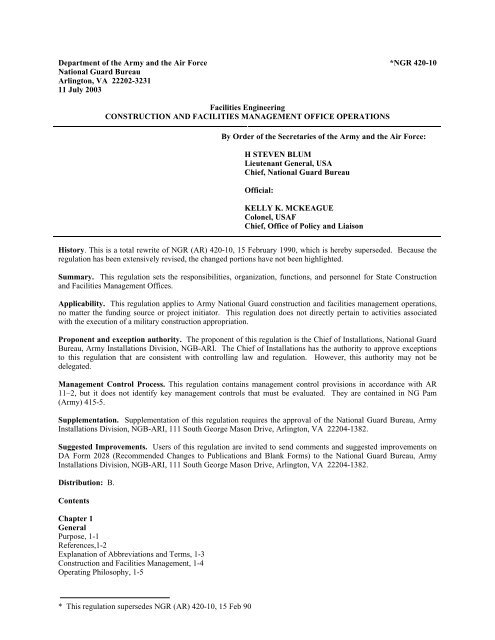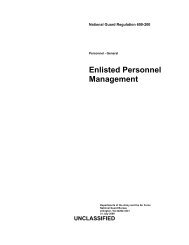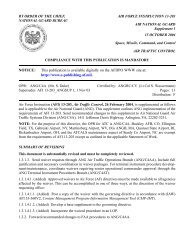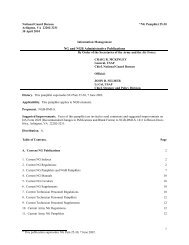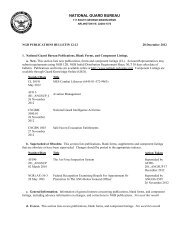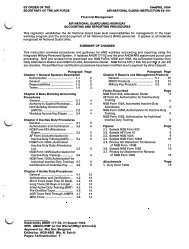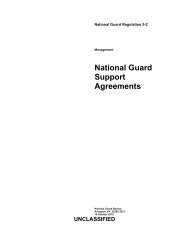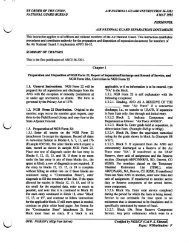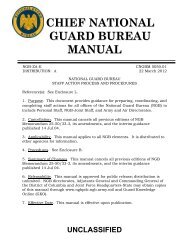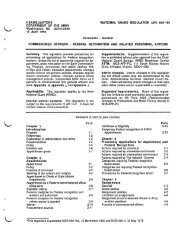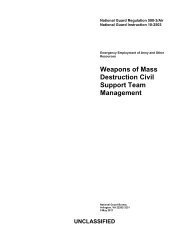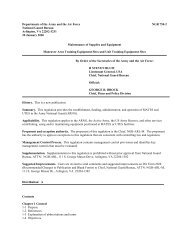NGR 420-10 - NGB Publications and Forms Library - U.S. Army
NGR 420-10 - NGB Publications and Forms Library - U.S. Army
NGR 420-10 - NGB Publications and Forms Library - U.S. Army
- No tags were found...
Create successful ePaper yourself
Turn your PDF publications into a flip-book with our unique Google optimized e-Paper software.
<strong>NGR</strong> <strong>420</strong>-<strong>10</strong> 11 July 2003OFFICE OFTHE CHIEFTRAINING SITEENGINEERINGACTIVITYCONTRACTMANAGEMENTPLANNINGANDPROGRAMMINGDESIGN &PROJECTMANAGEMENTRESOURCEMANAGEMENTENVIRONMENTALFACILITIESMANAGEMENTFigure 3-1. Construction <strong>and</strong> Facilities Management Office Organization.b. Functionally, the CFMO shall provide for the following:(1) Engineering operations, which include, but are not limited to, engineer troop construction programs <strong>and</strong>coordination of self-help programs.(2) Engineering plans <strong>and</strong> services, which include, but are not limited to, design <strong>and</strong> engineering services,real property master planning, programming of major construction, real property management, <strong>and</strong> facilities spacemanagement.(3) Buildings <strong>and</strong> grounds, including, but not limited to, sustainment, restoration, <strong>and</strong> modernization(including operations <strong>and</strong> maintenance construction) to the State’s buildings, structures, roads, railroads, hardst<strong>and</strong>s,airfields, <strong>and</strong> improved/semi-improved grounds, custodial services, pest control, self-help <strong>and</strong> preventivemaintenance programs, packing <strong>and</strong> crating services, <strong>and</strong> maintenance of Construction <strong>and</strong> Facilities ManagementOffice equipment.(4) Utilities, including, but not limited to, operation, sustainment, restoration, <strong>and</strong> modernization (includingconstruction) of the State's utility plants <strong>and</strong> systems, management of the State's fixed facilities energy conservationprogram, refuse <strong>and</strong> solid waste collection <strong>and</strong> disposal services, <strong>and</strong> recycling program management.(5) Environmental, natural <strong>and</strong> cultural resources management, which pertains to all environmental mediaprogram areas. Unless the comm<strong>and</strong>er adopts an alternative structure for different organizational placement as inparagraph 3-3, the chief of Environmental Programs shall report directly to the CFMO, but should have direct accessto the AG regarding significant environmental compliance issues.(6) Fire <strong>and</strong> emergency services, which include, but are not limited to, all fire fighting (except aircraft) bycivilian or military personnel, fire prevention (technical services), hazardous materials responses, confined spacerescue, <strong>and</strong> ancillary services.(7) Sustainment, restoration, <strong>and</strong> modernization (including operations <strong>and</strong> maintenance construction) supplysupport, which includes management of Construction <strong>and</strong> Facilities Management Office supply <strong>and</strong> storageactivities, property accountability for Construction <strong>and</strong> Facilities Management Office equipment, <strong>and</strong> performanceor oversight of delegated contract administration tasks, including quality assurance surveillance <strong>and</strong> evaluation ofcontractor performance.(8) Public works resources management, which includes financial planning, programming, budgeting, budgetexecution, accounting <strong>and</strong> review activities; the work management program; work planning; managing internalinformation management systems support <strong>and</strong> coordinating external information management systems support; <strong>and</strong>8
11 July 2003 <strong>NGR</strong> <strong>420</strong>-<strong>10</strong>industrial engineering support to the directorate. Support activities may include reimbursable activities <strong>and</strong> agenciesthroughout the State.4-2. Planninga. The CFMO shall accomplish short <strong>and</strong> long range planning, with the Adjutant General’s approval, for futuredevelopment of l<strong>and</strong>, facilities, <strong>and</strong> infrastructure of the State, following published <strong>NGB</strong>-ARI master planningmethodology.b. The Real Property Development Plan.(1) Shall be the basis to support acquisition, management, <strong>and</strong> disposal of real property.(2) Shall serve as a framework <strong>and</strong> decision support tool for assisting in the allocation of availablesustainment, restoration, <strong>and</strong> modernization resources <strong>and</strong> for supporting requested military construction projects.(3) Shall identify the AG’s goals <strong>and</strong> objectives for development <strong>and</strong> operation of the State <strong>and</strong> its supportedinstallations, <strong>and</strong> shall identify the major work to be done to real property to assure continued mission performance.(4) Shall be kept up to date.c. The plans shall identify facilities that are not essential to missions <strong>and</strong> future development of the State <strong>and</strong> itsindividual installations <strong>and</strong> ensure that resources are not spent on such facilities.4-3. Business Practicesa. Review <strong>and</strong> analysis. The CFMO shall record all work for performance evaluation, for future planning <strong>and</strong>scheduling of similar work, <strong>and</strong> for reports required by higher authority. The value of review <strong>and</strong> analysis extends toall Construction <strong>and</strong> Facilities Management Office business practices to ensure that ARNG facilities are operated<strong>and</strong> maintained according to sound commercial practices <strong>and</strong> required Federal, State, <strong>and</strong> local st<strong>and</strong>ards.b. “Facilities Center” is the ARNG’s information management system used by <strong>NGB</strong> <strong>and</strong> Construction <strong>and</strong>Facilities Management Offices to track <strong>and</strong> maintain all facilities related data.c. Work <strong>and</strong> cost reporting.(1) Construction <strong>and</strong> Facilities Management Office records shall provide visibility over what, where, when,<strong>and</strong> how much work is being performed on real property facilities, including work performed by contractors.(2) Costs incurred by the Construction <strong>and</strong> Facilities Management Office for work on real property facilities,direct <strong>and</strong> reimbursable, regardless of Federal funding source or method of accomplishment, shall be reported onwork documents. The CFMO shall capture costs in enough detail to ensure compliance with project approvalauthority <strong>and</strong> the Chief Financial Officer Act, to develop accurate rates for reimbursable services, <strong>and</strong> to supportConstruction <strong>and</strong> Facilities Management Office review <strong>and</strong> analysis of work accomplished.d. Customer service. The CFMO shall establish <strong>and</strong> implement customer service st<strong>and</strong>ards. Customer service isa compelling factor in the improvement of business practices, evaluation of effectiveness, establishment of workst<strong>and</strong>ards, <strong>and</strong> cost considerations.e. Alternative methods <strong>and</strong> sources. The CFMO shall make maximum use of alternative performance methods<strong>and</strong> labor sources when necessary for providing services <strong>and</strong> executing projects.4-4. Sustainment, Restoration, <strong>and</strong> Modernizationa. Sustainment, restoration, <strong>and</strong> modernization shall be accomplished at a level that is economically justifiedwith the objectives of supporting mission requirements <strong>and</strong> preventing deterioration that will require majorrestoration or replacement. It is essential that the States use maintenance <strong>and</strong> repair st<strong>and</strong>ards, design guides, realproperty plans, <strong>and</strong> resource management plans together, not separately. The intent is to provide quality facilitiesusing durable, energy efficient, low maintenance cost items that ensure mission readiness <strong>and</strong> an excellent workingor living environment in accordance with the principles of Sustainable Design <strong>and</strong> Development <strong>and</strong> ForceProtection.b. Conditions that affect the level of sustainment, restoration, <strong>and</strong> modernization to be accomplished at a realproperty facility are:(1) Current use. The CFMO shall include the current use of a real property facility in real property records<strong>and</strong> other facilities engineering, housing, <strong>and</strong> environmental management documentation. The design <strong>and</strong> currentactual use of a real property facility shall be included in the real property database.(a) Current use is required for Installation Status Report purposes; that is, to analyze facility assets versusfacility requirements <strong>and</strong> determine facility ratings.(b) The minimum level of sustainment, restoration, <strong>and</strong> modernization for a real property facility in activeuse shall be full protection against deterioration <strong>and</strong> provision of a functional living <strong>and</strong> working environment.(c) The established sustainment, restoration, <strong>and</strong> modernization level shall ensure economic <strong>and</strong> efficient useof the facility for its intended purpose <strong>and</strong> for the expected period of active use. The priority given to sustainment of9
<strong>NGR</strong> <strong>420</strong>-<strong>10</strong> 11 July 2003(3) The CFMO must attach an explanation, which should reference NG Pam 415-12, for projects that willresult in buildings that exceed by <strong>10</strong>% the area for that facility type as shown on the current DA Form 2369-2-R(Tabulation of Existing <strong>and</strong> Required Facilities – Facilities Requirements) for the State.(4) Although the st<strong>and</strong>ard project documentation is an <strong>NGB</strong> Form <strong>420</strong>-R, the CFMO shall document aconstruction project on DD <strong>Forms</strong> 1390/1391 in the case of a complex project joint with a non-ARNG entity, inorder to better delineate scope <strong>and</strong> the appropriate cost share of the parties to the construction. The CFMO may alsodocument any other complex project on DD <strong>Forms</strong> 1390/1391.d. Approval of an <strong>NGB</strong> Form <strong>420</strong>-R only approves the project, does not provide funding, <strong>and</strong> in no wayobligates Federal funds.e. The Federal share of the project cost cannot exceed the statutory ceiling in <strong>10</strong> U.S.C. §18233a(b). TheAdjutant General <strong>and</strong> the USPFO jointly shall establish controls to prevent projects from exceeding approval limits.If it becomes apparent that the projected total funded cost of an operations <strong>and</strong> maintenance construction project willexceed the statutory limit, all work shall be halted immediately, the CFMO shall notify <strong>NGB</strong>-ARI, <strong>and</strong> the CFMOshall begin processing a request for Military Construction Appropriation funds.f. The following practices constitute statutory violations <strong>and</strong> are prohibited:(1) Acquisition or improvement of real property facilities through a series of operations <strong>and</strong> maintenanceconstruction projects.(2) Subdivision of a construction project to reduce costs to a level that meets a statutory limitation, or thesplitting or incrementing of a project to reduce costs below an approval or contracting threshold.(3) Development of an operations <strong>and</strong> maintenance construction project solely to reduce the cost of an activemilitary construction project below the level at which Congress must be informed of a cost variation.g. Operations <strong>and</strong> Maintenance construction authority shall not be used to begin or complete constructionprojects contained in the annual Military Construction Authorization Act, nor be used as a basis for completingprojects financed under other authorizations when available funding is lacking.h. Any project proposed under operations <strong>and</strong> maintenance construction authority that has been previouslydenied authorization by Congress requires approval by the Secretary of the <strong>Army</strong> or designee, regardless of cost.i. Project cost limitations in effect at the time of approval of an operations <strong>and</strong> maintenance construction projectremain in effect throughout the life of the project.j. Throughout the term of a lease, expenditures for sustainment, restoration, <strong>and</strong> modernization, includingoperations <strong>and</strong> maintenance construction, for leased facilities may not exceed 25% of the first year’s rental, exceptthat in the case of a nominal rental fee the projects may not cost more than 15% of the fair market value of thefacility.k. The Joint Services Reserve Component Facility Board must first review <strong>and</strong> approve any indoor rangeproject.5-3. Sustainment, Restoration, <strong>and</strong> Modernization (Less Construction) Projectsa. Terms.(1) Sustainment consists of maintenance <strong>and</strong> repair activities necessary to keep an inventory of facilities ingood working order. It includes regularly scheduled adjustments <strong>and</strong> inspections, preventive maintenance tasks, <strong>and</strong>emergency response <strong>and</strong> service calls for minor repairs. It also includes major repairs or replacement of facilitycomponents (usually accomplished by contract) that are expected to occur periodically throughout the life cycle offacilities. This work includes regular roof replacement, refinishing of wall surfaces, repairing <strong>and</strong> replacement ofheating <strong>and</strong> cooling systems, replacing tile <strong>and</strong> carpeting, <strong>and</strong> similar types of work. It does not includel<strong>and</strong>scaping, mowing, soil stabilization, <strong>and</strong> similar activities, which are defined as municipal services.(2) Restoration includes repair <strong>and</strong> replacement work to restore facilities damaged by lack of sustainment,excessive age, natural disaster, fire, accident, or other causes. It reduces the backlog of facilities rated C-3 <strong>and</strong> C-4on the Installation Status Report. Restoration may overhaul, reprocess, or replace deteriorated component parts ormaterials to current industry st<strong>and</strong>ards. Restoration is also the relocation or reconfiguration of l<strong>and</strong> <strong>and</strong> buildingcomponents <strong>and</strong> utility systems <strong>and</strong> the upgrade of the same to current building <strong>and</strong> other codes.(3) Modernization includes constructing new or altering existing facilities solely to implement new or higherst<strong>and</strong>ards (including regulatory changes), to accommodate new functions (or change the purpose of a facility), or toreplace building components that typically last more than 50 years (such as foundations <strong>and</strong> structural members).b. Projects costing less than $<strong>10</strong>0,000 in Federal share.(1) The CFMO shall classify <strong>and</strong> certify the project.(2) The CFMO is the approval authority <strong>and</strong> no <strong>NGB</strong> Form <strong>420</strong>-R is required, provided that the CFMOmaintains an auditable trail, satisfactory to the USPFO.(3) Such CFMO approval, however, in no way obligates Federal funds.12
11 July 2003 <strong>NGR</strong> <strong>420</strong>-<strong>10</strong>c. Projects costing at least $<strong>10</strong>0,000 in Federal share.(1) The CFMO shall classify <strong>and</strong> certify all sustainment, restoration, <strong>and</strong> modernization (less construction)projects on an <strong>NGB</strong> Form <strong>420</strong>-R.(2) The approval authority is the USPFO for all projects with a Federal share between $<strong>10</strong>0,000 <strong>and</strong> $3million.(3) All projects above $3 million in cost must be documented on DD <strong>Forms</strong> 1390/1391 <strong>and</strong> submittedthrough <strong>NGB</strong>-ARI to the Assistant Secretary of the <strong>Army</strong> (Installations <strong>and</strong> Environment) for approval.(4) Although the st<strong>and</strong>ard project documentation is an <strong>NGB</strong> Form <strong>420</strong>-R, the CFMO shall use DD <strong>Forms</strong>1390/1391 in the case of a complex project joint with a non-ARNG entity, in order to better delineate scope <strong>and</strong> theappropriate cost share of the parties. The CFMO may also document any other complex project on DD <strong>Forms</strong>1390/1391.d. Demolition projects on Federally owned l<strong>and</strong> are an exception to paragraphs 5-3b <strong>and</strong> 5-3c above.(1) The CFMO shall certify all such projects on an <strong>NGB</strong> Form <strong>420</strong>-R.(2) The approval authority is the USPFO no matter what the Federal share.e. Approval of an <strong>NGB</strong> Form <strong>420</strong>-R only approves the project, does not provide funding, <strong>and</strong> in no wayobligates Federal funds.f. Projects shall not proceed unless:(1) The restoration cost (or restoration, modernization, <strong>and</strong> alterations cost for a combined undertaking) doesnot exceed 50 percent of the replacement cost of the facility for projects whose funded costs are greater than$750,000. However, if the project cost exceeds 50% of the replacement cost, the State may apply to <strong>NGB</strong>-ARI foran exception to policy.(2) Environmental documentation has been completed in accordance with AR 200-1, AR 200-2, AR 200-3,AR 200-4, <strong>and</strong> AR 200-5.(3) Projects, regardless of costs, are consistent with force structure plans, are more cost effective thanreplacement, <strong>and</strong> are an appropriate use of operations <strong>and</strong> maintenance funds.(4) For restoration or modernization projects involving indoor ranges, the Joint Services Reserve ComponentFacility Board has first reviewed the project.5-4. Project Costsa. When sustainment, restoration, <strong>and</strong> modernization, including construction, are combined into oneundertaking, each may be treated as a separate project for approval limitation purposes. Engineering estimates maybe used to allocate the funded costs between construction <strong>and</strong> the other components. This will determine projectapproval authority. When the work is so integrated that separation of construction from the other components is notpossible, the entire undertaking shall be funded as one construction project. In this case the operations <strong>and</strong>maintenance construction limit shall apply to the one, overall project.b. Appropriations that finance the project shall be used to reimburse other appropriations for all Federallyfunded costs initially financed by such other appropriations. Funded costs include --(1) The Federal share of the purchase of real property, materials, supplies, services, rental trailers <strong>and</strong>buildings, utilities, or other items applicable to the project.(2) Installed capital equipment <strong>and</strong> installed building equipment.(3) Transportation costs applicable to materials, supplies, real property items, installed equipment, <strong>and</strong>Government-owned equipment.(4) Civilian labor costs, including State civilian prisoner labor if this labor is Federally reimbursed.(5) Contracted supervision <strong>and</strong> inspection costs. These include your Title II/Type C A-E services(Supervision, Inspection, <strong>and</strong> Overhead).(6) Troop travel <strong>and</strong> per diem directly related to the project for soldiers who are doing actual site preparation<strong>and</strong> construction, if these costs were incurred solely because of the construction project. (This is not the same asnormal CFMO project management.) (See paragraph 5-4e(9) for more details.)(7) Costs for maintenance <strong>and</strong> operation of government-owned equipment (including organic troop unitequipment) <strong>and</strong> rental cost for non-Government equipment.(8) Costs for preparation of operation <strong>and</strong> maintenance manuals for installed systems.(9) Demolition <strong>and</strong> site preparation costs.(<strong>10</strong>) The cost of installing equipment in place in new facilities.(11) Costs of mitigation identified in environmental documentation completed in accordance with AR 200-2.c. For purposes of work classification <strong>and</strong> project capitalization, the total funded cost of a multi-year projectover $750,000 on a single real property facility shall include all phases of the project.d. In comparing funded project costs with facility replacement cost, all known major repairs <strong>and</strong> alterations tothe facility will be included. Replacement cost will be based on a facility of the same square footage <strong>and</strong> same type13
<strong>NGR</strong> <strong>420</strong>-<strong>10</strong> 11 July 2003construction (temporary, semi-permanent or permanent), <strong>and</strong> may be computed using the methodology <strong>and</strong> costtables of TM 5-800-4. In determining the replacement cost, any costs of demolition, asbestos removal, site work,<strong>and</strong> historic considerations shall be included.e. Unfunded project costs are limited to the following. Unfunded costs do not count against approval <strong>and</strong>statutory limits, but the sum of the funded <strong>and</strong> unfunded costs constitute the amount at which the CFMO shallcapitalize the project in the Federal real property files <strong>and</strong> the Federal real property database.(1) Costs financed from military personnel appropriations.(2) Depreciation of government-owned equipment (except depreciation cost of a plant owned by capitalworking funds).(3) Materials, supplies, <strong>and</strong> items of installed building equipment that have been obtained from other U.S.Government agencies or foreign governments without reimbursement. When such items become available as excessdistributions from other government agencies, their value shall be at Federal Supply Catalog.(4) Costs of real property items relocated on the same installation except transportation <strong>and</strong> relocation costs.(5) Planning, engineering, <strong>and</strong> design costs before construction. These include your Title I/Type A <strong>and</strong> B A-E services.(6) Costs for licenses <strong>and</strong> permits required by State or local laws for pollution abatement.(7) Materiel costs of equipment-in-place items obtained on a non-reimbursable basis.(8) Federal military prisoner <strong>and</strong> Federal civilian prisoner labor. Use of State civilian prisoner labor is a nonfundedcost as long as the State Military Department does not receive Federal reimbursement for their services.(9) Costs for travel <strong>and</strong> per diem for troop labor if the construction project is only part of a larger activity,such as an annual training exercise. That is, the travel <strong>and</strong> per diem for troop labor is a funded project cost if thesole purpose of bringing the troops to a site is to assist in the project, even if the project is considered troop training.However, the travel <strong>and</strong> per diem is an unfunded project cost if the project work is incidental to a larger trainingexercise.5-5. Technical ReviewsAll technical reviews are the responsibility of the CFMO, except security reviews pertaining to projects for facilitiesthat involve the electronic processing of classified material (<strong>and</strong> projects which include provision of a radiofrequency interference or TEMPEST shielded enclosure). The State official responsible for TEMPEST securityshall accomplish this technical review in the initial planning stages of a project. Requirements for shieldedenclosures must be approved by The Deputy Chief of Staff for Intelligence (DAMI-CI), <strong>10</strong>00 <strong>Army</strong> Pentagon,Washington, D.C. 203<strong>10</strong>-<strong>10</strong>00.5-6. Act of Nature Damage ProjectsExpedited project approval <strong>and</strong> execution procedures shall be used for projects for restoration of facilities damagedby fire, storm, flood, freeze or other natural occurrences, regardless of the project funding source. Necessaryapprovals <strong>and</strong> Congressional notifications shall be obtained while prospective contractors are preparing theirproposals. The CFMO should begin <strong>and</strong> complete work on the project as quickly as possible. Submissionrequirements are contained in <strong>NGB</strong>-AQ cooperative agreement directives.5-7. Real Property Facility Project Filesa. The CFMO shall establish a project file for each project within the scope of this regulation when constructioncosts are $25,000 or more <strong>and</strong> when other sustainment, restoration, <strong>and</strong> modernization costs are $<strong>10</strong>0,000 or more.For single undertakings involving both construction <strong>and</strong> other sustainment, restoration, <strong>and</strong> modernization activities,only one project file will be established. Electronic document processing <strong>and</strong> storage may be used for these files.Each file shall represent a complete historical record of a project, from inception to filing of the actual costsincurred, <strong>and</strong> shall contain, if applicable, the following documentation for each project:(1) <strong>NGB</strong> Form <strong>420</strong>-Rs <strong>and</strong>/or appropriate State forms. The file may contain more than one work request, if itis desired to control each classification of work.(2) Record of estimates, justification for the project (to include environmental <strong>and</strong> safety considerations <strong>and</strong>requirements which the project addressed), <strong>and</strong> related correspondence (initial estimate, identification of estimator,<strong>NGB</strong> Form <strong>420</strong>-R or DD <strong>Forms</strong> 1390/1391, job phase calculation sheets, identification of funded <strong>and</strong> unfundedcosts, calculations to illustrate how costs were developed, identification of crafts involved, <strong>and</strong> source documentsused for the estimates, etc).(3) Requests for approval <strong>and</strong> signed approval documents, including letters, estimates, specifications, <strong>and</strong>plans.(4) National Environmental Policy Act, National Historic Preservation Act, Occupational Health <strong>and</strong> SafetyAdministration, code reviews, <strong>and</strong> similar type findings, reviews, <strong>and</strong> approvals associated with the project.14
11 July 2003 <strong>NGR</strong> <strong>420</strong>-<strong>10</strong>(5) Revised plans <strong>and</strong> estimates, if changes to these documents were required by the approving authority.(6) On projects approaching regulatory or statutory limitations, a day-to-day blotter record showing all actualcosts incurred to date. Maintenance <strong>and</strong> analysis of this blotter record should prevent violation of the Anti-Deficiency Act.(7) Appropriate contractual documents, to include inspection <strong>and</strong> final acceptance reports.(8) DD Form 1354 properly signed <strong>and</strong> dated. This applies whether or not the project is on Federal l<strong>and</strong>.(9) Warranty schedules <strong>and</strong> dates.b. Project files should include other documentation that is pertinent to the history of the project, such as:(1) A document signed by the requesting agency indicating when the need for a construction project becameknown, when the work must be completed, <strong>and</strong> what the consequences would be if the project were not completedby the specified time.(2) A notation that the inventory of military real property has been changed to include the sum of the actualfacilities engineering, architectural, <strong>and</strong> other outside services for design, plan, specification, <strong>and</strong> survey costs of aconstruction project. (The changes shall be reported in the real property data base.)(3) Documentation of proper posting to the real property database of any changes in facility use codes <strong>and</strong>required capitalization for all construction projects <strong>and</strong> real property improvements in excess of $<strong>10</strong>0,000.c. Project files should be retained for at least three years after completion of the project, unless the Statespecifies a longer retention period.Chapter 6Personnel6-1. Manpower GuidanceManpower guidance is based on <strong>NGB</strong> manpower studies <strong>and</strong> allocations from the Facilities Programs PersonnelAllocation St<strong>and</strong>ard (FP-PAS) <strong>and</strong> the <strong>NGB</strong>-ARE Environmental Manning Model. (For details on the latter two,see <strong>NGB</strong>-AQ cooperative agreement directives <strong>and</strong> <strong>NGB</strong>-ARE policy <strong>and</strong> guidance memor<strong>and</strong>a.) The formerallocates positions to accomplish Federal facilities engineering responsibilities, <strong>and</strong> the latter two allocate personnelto support the State’s responsibilities under the cooperative agreement.6-2. Assignment of Personnela. This regulation does not provide authority to establish positions, civilian personnel grade levels, orclassification for any given set of duties, functions, or responsibilities. Positions are to be filled by personnel whomeet the requirements of the appropriate job series in Office of Personnel Management qualification st<strong>and</strong>ards.Provided that these qualifications are met, there is no requirement that military personnel be branched <strong>Army</strong> Corpsof Engineers.b. Engineer positions. The following key positions are normally filled by qualified engineers, facility managers,project managers, or technical professionals. Longevity of assignment in these positions is strongly encouraged.These qualifications <strong>and</strong> the recommended tenure are particularly important in the case of the CFMO.(1) CFMO.(2) Chief, Planning <strong>and</strong> Programming(3) Chief, Design <strong>and</strong> Project Management(4) Chief, Facility Managementc. Other key positions.(1) The Chief of Environmental Programs should have a combination of education <strong>and</strong> experience in theenvironmental sciences with management skills <strong>and</strong> be a qualified environmental engineer, environmental planner,environmental protection specialist, natural resources scientist, or historic preservation specialist. Certification as aRegistered Environmental Manager is recommended.(2) The principal master planner should be a qualified planner, architect, or engineer.(3) There should be a qualified fire services professional to lead the fire <strong>and</strong> emergency services program.6-3. Use of Civilian Personnel, Inmate Labor, or Troopsa. Sustainment, restoration, modernization, <strong>and</strong> operation of real property shall be done through the mosteconomical means available, consistent with mission <strong>and</strong> statutory requirements. AR 570-4 prescribes policieswhich apply to the use of non-CFMO personnel <strong>and</strong> soldiers in performing Construction <strong>and</strong> Facilities ManagementOffice activities using Federal procedures.b. Inmate labor can be used under carefully controlled circumstances as a more economical method of providingsome base services.15
<strong>NGR</strong> <strong>420</strong>-<strong>10</strong> 11 July 2003c. State law applies to the use of State inmates <strong>and</strong> other non-st<strong>and</strong>ard personnel in performing Construction <strong>and</strong>Facilities Management Office activities using State procedures.6-4. Training <strong>and</strong> Education ProgramsThe CFMO shall develop a training program that identifies training needs <strong>and</strong> maintains management <strong>and</strong> technicalproficiency of Construction <strong>and</strong> Facilities Management Office personnel. Public works <strong>and</strong> related professionaltraining opportunities, appropriate certifications, <strong>and</strong> State licenses should be part of the training plan.16
11 July 2003 <strong>NGR</strong> <strong>420</strong>-<strong>10</strong>Appendix AReferencesMost of these references are available electronically as listed below:1. United States Code:www4.law.cornell.edu/uscode/ orwww.access.gpo.gov/congress/cong013.html orhttp://uscode.house.gov/usc.htm.2. Code of Federal Regulations: www.access.gpo.gov/nara/cfr/cfr-retrieve.html#page1.3. Executive Orders: www.nara.gov/fedreg/eo.html. However, this reference, except for recent executiveorders, only provides a summary <strong>and</strong> citations to the Federal Register. The address of the Federal Register iswww.access.gpo.gov/nara/index.html.4. Office of Management <strong>and</strong> Budget Circulars: www.whitehouse.gov/omb/circulars/.5. Acquisition Regulations:www.arnet.gov/far/ orwww.acq.osd.mil/dp/dars/dfars.html orhttp://acqnet.sarda.army.mil/library/zpafar.htm.6. Department of Defense <strong>Publications</strong>: www.dtic.mil/whs/directives/.7. Department of Defense Financial Management Regulation: www.dtic.mil/comptroller/fmr/.8. DFAS <strong>Publications</strong>:www.asafm.army.mil/secretariat/document/dfas37-<strong>10</strong>0/dfas37-<strong>10</strong>0.asp <strong>and</strong>https://dfas4dod.dfas.mil/centers/dfasin/library/ar37-1/.9. <strong>Army</strong> Regulations <strong>and</strong> Pamphlets: www.usapa.army.mil/.<strong>10</strong>. Technical Manuals: www.usace.army.mil/inet/usace-docs/armytm/.11. National Guard Regulations <strong>and</strong> Pamphlets: www.ngbpdc.ngb.army.mil/.Section IRequired <strong>Publications</strong>AR 11-2Management Control. (Cited in para 2-9x.)AR 11-27<strong>Army</strong> Energy Program. (Cited in para 4-4b(5).)AR 40-5Preventive Medicine. (Cited in para 4-4b(2).)AR 55-80Highways for National Defense. (Cited in para 2-9p.)AR 200-1Environmental Protection <strong>and</strong> Enhancement. (Cited in paras 2-9i, 4-4b(4), 5-1h, <strong>and</strong> 5-3f(2).)AR 200-2Environmental Effects of <strong>Army</strong> Actions. (Cited in paras 2-9i, 4-4b(4), 5-1i, 5-3f(2), <strong>and</strong> 5-4b(11).)AR 200-3Natural Resources - L<strong>and</strong>, Forest, <strong>and</strong> Wildlife Management. (Cited in paras 2-9k, 4-4b(4), 5-1i, <strong>and</strong> 5-3f(2).)AR 200-4Cultural Resources Management (Cited in paras 2-9j, 4-4b(4), 5-1i, <strong>and</strong> 5-3f(2).)AR 200-5Pest Management (Cited in paras 2-9l, 5-1i, <strong>and</strong> 5-3f(2).)AR 385-<strong>10</strong><strong>Army</strong> Safety Program. (Cited in para 4-4b(2).)17
<strong>NGR</strong> <strong>420</strong>-<strong>10</strong> 11 July 2003AR 385-64US <strong>Army</strong> Explosives Safety Program. (Cited in para 5-1e(1).)AR 405-45Inventory of <strong>Army</strong> Military Real Property. (Cited in para 2-9h.)AR 405-70Utilization of Real Property. (Cited in para 2-9h.)AR 405-80Management of Title <strong>and</strong> Granting Use of Real Property. (Cited in para 2-9h.)AR 405-90Disposal of Real Estate. (Cited in para 3-4b(3).)AR <strong>420</strong>-49Utilities Services. (Cited in paras 2-9m <strong>and</strong> 4-4b(5).)AR <strong>420</strong>-90Fire Protection. (Cited in para 4-4b(2).)AR 570-4Manpower Management. (Cited in para 6-3a.)29 CFR Part 1900.2 – Part 1925.3Occupational Safety <strong>and</strong> Health Administration, Department of Labor. (Cited in para 4-4b(2).)DA Energy Resources Management Plan.(Cited in para 4-4b(5).) (This publication may be obtained from the Comm<strong>and</strong>er, U.S. <strong>Army</strong> Logistics EvaluationAgency, ATTN: LOEA-PL, New Cumberl<strong>and</strong>, PA 17070-5007.)DA Pam 415-28Guide to <strong>Army</strong> Real Property Codes. (Cited in para 5-1d.)DA Pam <strong>420</strong>-11Project Definition <strong>and</strong> Work Classification. (Cited in para 5-1b.)DoDI 1225.8Programs <strong>and</strong> Procedures for Reserve Component Facilities Programs <strong>and</strong> Unit Stationing. (Cited in para 2-9w.)ISO 14001Environmental Management Systems – Specification with Guidance for Use. (Cited in para 2-6b.)MIL-STD-3007St<strong>and</strong>ard Practice For Unified Facilities Criteria And Unified Facilities Guide Specifications. (Cited in para 5-1a.)NG Pam (AR) 415-12<strong>Army</strong> National Guard Facilities Allowances. (Cited in paras 5-1a <strong>and</strong> 5-2c(3).)NG Pam (AR) <strong>420</strong>-<strong>10</strong>Construction <strong>and</strong> Facilities Management Office Procedures. (Cited in para 5-1b.)<strong>NGR</strong> 405-80<strong>Army</strong> National Guard Real Estate Program. (Cited in para 2-9h.)<strong>NGR</strong> 415-<strong>10</strong><strong>Army</strong> National Guard Facilities Construction. (Cited in para 5-1a.)18
11 July 2003 <strong>NGR</strong> <strong>420</strong>-<strong>10</strong>TM 5-654Gas Distribution Systems Operation Maintenance. (Cited in para 4-4b(2).)TM 5-800-4Programming Cost Estimates for Military Construction. (Cited in para 5-4d.)USATCESP 385-02Site <strong>and</strong> General Construction Plan Developers Guide. (Cited in para 5-1e(4).)<strong>10</strong> U.S.C. §18233a(b)Facilities for Reserve Components, Limitation on Certain Projects. (Cited in para 5-2e.)16 U.S.C. §470 et. seq.National Historic Preservation Act. (Cited in paras 5-1i <strong>and</strong> 5-7a(4).)31 U.S.C. §§ 6301-6308Using Procurement Contracts <strong>and</strong> Cooperative Agreements. (Cited in para 1-5b.)42 U.S.C. §§4321-4370aNational Environmental Policy Act. (Cited in para 5-1i.)Section IIRelated <strong>Publications</strong>AR 1-33Memorial ProgramsAR 2<strong>10</strong>-14The <strong>Army</strong> Installations Status Report ProgramAR 350-4Integrated Training Area ManagementAR 385-<strong>10</strong>The <strong>Army</strong> Safety ProgramAR 385-16System Safety Engineering <strong>and</strong> ManagementAR 385-63Policies <strong>and</strong> Procedures for Firing Ammunition for Training, Target Practice, <strong>and</strong> CombatAR 405-<strong>10</strong>Acquisition of Real Property <strong>and</strong> Interests ThereinAR 415-28Real Property Category CodesAR 415-32Engineer Troop Unit Construction in Connection with Training ActivitiesAR <strong>420</strong>-18Facility Engineering Materials, Equipment, <strong>and</strong> Relocatable Building ManagementAR <strong>420</strong>-70Buildings <strong>and</strong> Structures19
<strong>NGR</strong> <strong>420</strong>-<strong>10</strong> 11 July 200331 CFR Part 205Rules <strong>and</strong> Procedures for Funds Transfers32 CFR Part 33Uniform Administrative Requirements For Grants And Cooperative Agreements To State And Local Governments36 CFR Part 800Protection of Historic PropertiesDA Pam 385-64Ammunition <strong>and</strong> Explosive Safety St<strong>and</strong>ardsDA Pam 405-45Real Property Inventory ManagementDA Pam <strong>420</strong>-7Natural Resources - L<strong>and</strong>, Forest, <strong>and</strong> Wildlife ManagementDFAS Manual 37-<strong>10</strong>0-XXThe <strong>Army</strong> Management StructureDoDD 1225.7Reserve Component Facilities Programs <strong>and</strong> Unit StationingDoDD 32<strong>10</strong>.6Defense Grant <strong>and</strong> Agreement Regulatory SystemDoDD 6055.9DoD Explosives Safety Board (DDESB) And DoD Component Explosives Safety ResponsibilitiesDoDD 7600.<strong>10</strong>Audits of State <strong>and</strong> Local Governments, Institutions of Higher Education, <strong>and</strong> Other Nonprofit InstitutionsDoDI 4000.19Interservice <strong>and</strong> Intragovernmental SupportNG Pam (AR) 25-1Training Site General InformationNG Pam (AR) 385-16Guidelines for Converting Indoor Firing Ranges to Other UsesNG Pam 415-5<strong>Army</strong> National Guard Military Construction Program Execution<strong>NGR</strong> 5-3ARNG Training Centers<strong>NGR</strong> 11-27ARNG Energy Conservation Plan<strong>NGR</strong> 130-6United States Property <strong>and</strong> Fiscal Officer: Appointment, Duties <strong>and</strong> Responsibilities<strong>NGR</strong> 200-3State <strong>and</strong> Federal Environmental Responsibilities20
11 July 2003 <strong>NGR</strong> <strong>420</strong>-<strong>10</strong><strong>NGR</strong> 335-<strong>10</strong><strong>Army</strong> National Guard Management Control System<strong>NGR</strong> 385-<strong>10</strong><strong>Army</strong> National Guard Safety <strong>and</strong> Occupational Health Program<strong>NGR</strong> 385-15Policy, Responsibilities, <strong>and</strong> Procedures for Inspection/Evaluation, <strong>and</strong> Use of ARNG Indoor Ranges<strong>NGR</strong> 415-5<strong>Army</strong> National Guard Military Construction Program Development <strong>and</strong> ExecutionOMB Circular A-87Cost Principles for State, Local, <strong>and</strong> Indian Tribal GovernmentsOMB Circular A-89Federal Domestic Assistance Program InformationOMB Circular A-<strong>10</strong>2Grants <strong>and</strong> Cooperative Agreements with State <strong>and</strong> Local GovernmentsOMB Circular A-123Internal Control SystemsOMB Circular A-133Audits of States, Local Governments, <strong>and</strong> Non-Profit OrganizationsTM 5-634Solid Waste ManagementTM 5-683Electrical Interior FacilitiesTM 5-684Electrical Exterior FacilitiesTM 5-815-2Utility Monitoring <strong>and</strong> Control Systems<strong>10</strong> U.S.C. Chapter 159Real Property<strong>10</strong> U.S.C. Chapter 169Military Construction <strong>and</strong> Military Family Housing<strong>10</strong> U.S.C. Chapter 1803Facilities for Reserve Components31 U.S.C. Chapter 65Intergovernmental Cooperation31 U.S.C. Chapter 75Requirements for Single Audits21
<strong>NGR</strong> <strong>420</strong>-<strong>10</strong> 11 July 2003Section IIIPrescribed <strong>Forms</strong><strong>NGB</strong> Form <strong>420</strong>-ROMNG Project Request. (Cited in paras 2-8c, 2-9u, 5-1b, 5-1b(1), 5-1b(2), 5-1d, 5-2b(2), 5-2c(4), 5-2d, 5-3b(2), 5-3c(1), 5-3c(4) 5-3d(1), 5-3e, <strong>and</strong> 5-7a(1).)Section IVReferenced <strong>Forms</strong>DA Form 2369-2-RTabulation of Existing <strong>and</strong> Required Facilities – Facilities Requirements. (Cited in para 5-2c(3).)DA Form 2702Bill of Materials. (Cited in para 5-7a(1).)DD Form 1354Transfer <strong>and</strong> Acceptance of Military Real Property. (Cited in paras 2-8d <strong>and</strong> 5-7a(6).)DD Form 1390FY__ Military Construction Program. (Cited in paras 2-9u, 5-1b, 5-2c(4), 5-3c(3), 5-3c(4), <strong>and</strong> 5-7a(1).)DD Form 1391FY __ Military Construction Project Data. (Cited in paras 2-9u, 5-1b, 5-2b(3), 5-3b(3), 5-3b(4), <strong>and</strong> 5-7a(1).)22
11 July 2003 <strong>NGR</strong> <strong>420</strong>-<strong>10</strong>GlossarySection IAbbreviationsA-EArchitect-EngineeringAGAdjutant GeneralAR<strong>Army</strong> RegulationARNG<strong>Army</strong> National GuardASIP<strong>Army</strong> Stationing <strong>and</strong> Inventory PlanCFMOConstruction <strong>and</strong> Facilities Management OfficerCFRCode of Federal RegulationsC<strong>NGB</strong>Chief, National Guard BureauDADepartment of the <strong>Army</strong>DDDepartment of DefenseDDESBDepartment of Defense Explosives Safety BoardDoDDepartment of DefenseDoDDDepartment of Defense DirectiveDoDIDepartment of Defense InstructionFISPFacilities Inventory <strong>and</strong> Support PlanFP-PASFacilities Programs Personnel Allocation St<strong>and</strong>ardGISGeographical Information System23
<strong>NGR</strong> <strong>420</strong>-<strong>10</strong> 11 July 2003ISOInternational Organization for St<strong>and</strong>ardizationITAMIntegrated Training Area ManagementMEOMost Efficient OrganizationMILCONMilitary ConstructionNEPANational Environmental Policy ActNGNational Guard<strong>NGB</strong>National Guard Bureau<strong>NGB</strong>-AQNational Guard Bureau Acquisition<strong>NGB</strong>-ARE<strong>Army</strong> Environmental Programs Division<strong>NGB</strong>-ARI<strong>Army</strong> Installations Division<strong>NGB</strong>-AVS<strong>Army</strong> Aviation <strong>and</strong> Safety Division<strong>NGR</strong>National Guard RegulationOMBOffice of Management <strong>and</strong> BudgetOPROffice of Primary ResponsibilityOSDOffice of the Secretary of DefensePamPamphletRPDPReal Property Development PlanTMTechnical ManualUSATCESPU.S. <strong>Army</strong> Technical Center for Explosives Safety Publication24
11 July 2003 <strong>NGR</strong> <strong>420</strong>-<strong>10</strong>U.S.C.United States CodeUSPFOUnited States Property <strong>and</strong> Fiscal OfficerSection IITermsCanceled FundsAn appropriation, five years after the entire period of availability for its obligation has ended. In the case of almostall operations <strong>and</strong> maintenance appropriations this is at midnight on 30 September five years after the fiscal yearnamed on the appropriation. At this time the appropriation shall be closed <strong>and</strong> any remaining balance (whetherobligated or unobligated) in the account shall be canceled <strong>and</strong> thereafter shall not be available for obligation orexpenditure for any purpose.ConstructionThe erection, installation, or assembly of a new facility; the relocation of a facility; the complete replacement of anexisting facility; or the addition, expansion, extension, alteration, or conversion (to a new type use) of an existingfacility. This includes installed building equipment <strong>and</strong> related site preparation, excavation, filling <strong>and</strong> l<strong>and</strong>scapingor other l<strong>and</strong> improvements. It also includes increases in components of facilities for functional reasons when afacility is not being repaired <strong>and</strong> the components are not required to meet current st<strong>and</strong>ards, <strong>and</strong> it includes theextension of utilities to areas not previously served. Construction is an activity that may be a part of either therestoration or modernization program.DemolitionThe complete dismantling, tearing down, razing, wrecking, or burning of a fixed building or facility, to include theremoval of foundations, utilities, <strong>and</strong> all debris, the backfill of all areas excavated by the work to maintain sitegrades <strong>and</strong> contours, <strong>and</strong> the reseeding of the property.Expired FundsAn appropriation, when balances no longer are available for incurring new obligations, because the time availablefor making such obligations has expired. In the case of almost all operations <strong>and</strong> maintenance appropriations this isat midnight on 30 September of the fiscal year named on the appropriation. At this time the appropriation is onlyavailable.FacilityA separate <strong>and</strong> individual building, structure, utility system, or other real property improvement identifiable with acategory code from DA Pam 415-28. Supporting elements for structures, such as sidewalks, fire hydrants, gasoline<strong>and</strong> diesel fuel dispensing systems, flammable materials buildings, roads, fencing, <strong>and</strong> hard st<strong>and</strong>, are all separatefacilities.Facilities CenterA customized version of a commercial off the shelf computer integrated facilities management system. It serves asthe ARNG’s information management system used by <strong>NGB</strong> <strong>and</strong> the CFMOs to manage real property assets fromcradle to grave <strong>and</strong> to track <strong>and</strong> maintain all facilities related data, including project data.Facilities Inventory <strong>and</strong> Support Plan (FISP)An electronic document to provide detailed information on all Federally/State owned, State operated, ARNGfacilities within each individual State, Commonwealth, or Territory. It details information on structures, activities,locations, <strong>and</strong> lists other pertinent data required for Federal participation for support. It identifies facilities, toinclude those that are eligible for support with Federal funds.InstallationAn aggregation of contiguous or near contiguous, common mission-supporting real property holdings under thejurisdiction of the State, the District of Columbia, Territory, or Commonwealth controlled by <strong>and</strong> at which anARNG unit or activity is permanently assigned. For the purpose of Installation Status Report reporting <strong>and</strong> the25
<strong>NGR</strong> <strong>420</strong>-<strong>10</strong> 11 July 2003calculation of programming inventory, each State shall be considered a separate installation. However, for realproperty inventory reporting, each entity with a FISP installation number will be reported as an installation.MaintenanceThe work required to preserve <strong>and</strong> maintain a piece of real property or a real property facility in such condition thatit may be effectively used for its designated functional purpose. It includes work done to sustain existingcomponents (such as renewal of disposable filers, painting, caulking, refastening loose siding, <strong>and</strong> sealing asphaltpavement) <strong>and</strong> cyclic work done to prevent damage which would be more costly to restore than to prevent.Maintenance is an activity that is part of the sustainment program.ModernizationThe construction of new or alteration of existing facilities solely to implement new or higher st<strong>and</strong>ards (includingregulatory changes), to accommodate new functions (or change the purpose of a facility), or to replace buildingcomponents that typically last more than 50 years (such as foundations <strong>and</strong> structural members). Modernization is aprogram, <strong>and</strong> as such must be distinguished from the activities that make it up: repair <strong>and</strong> construction.Primary FacilityMain facility or facility complex required to perform an essential mission or function.Real Property Development Plan (RPDP)The constantly updated end product of the State’s real property master planning process. It identifies the AdjutantGeneral’s goals <strong>and</strong> objectives for development <strong>and</strong> operation of the State <strong>and</strong> its supported installations <strong>and</strong> shallidentify the major work to be done to real property to ensure continued mission performance. It becomes the basisto support acquisition, management, accountability, <strong>and</strong> disposal of real property <strong>and</strong> serves as a framework forallocating available sustainment, restoration, <strong>and</strong> modernization resources <strong>and</strong> to support requested militaryconstruction projects.Real Property ImprovementAn improvement which increases a real property asset’s square footage, size, efficiency, or useful life. That is, if areplacement was undertaken to improve or exp<strong>and</strong> the efficiency of an asset that was in good working order, thenthe replacement is a construction activity that needs to be capitalized. When a facility or facility component hasfailed, is in the incipient stages of failing or is no longer performing the functions for which it was designated, it isconsidered a repair activity <strong>and</strong> should not be capitalized.RepairThe restoration of a piece of real property or a real property facility to such condition that it may effectively be usedfor its designated functional purpose. Repair may be to overhaul, reprocess, or replace deteriorated component partsor materials. It may also include the relocation or reconfiguration of l<strong>and</strong> <strong>and</strong> building components <strong>and</strong> utilitysystems <strong>and</strong> the upgrade of the same to current building <strong>and</strong> other codes. Repair is an activity that may be a part ofthe sustainment, restoration, or modernization programs.RestorationRepair <strong>and</strong> replacement work to restore facilities damaged by lack of sustainment, excessive age, natural disaster,fire, accident, or other causes. It reduces the backlog of facilities rated C-3 <strong>and</strong> C-4 on the Installation StatusReport. Restoration may be to overhaul, reprocess, or replace deteriorated component parts or materials to currentindustry st<strong>and</strong>ards. Restoration is also the relocation or reconfiguration of l<strong>and</strong> <strong>and</strong> building components <strong>and</strong> utilitysystems <strong>and</strong> the upgrade of the same to current building <strong>and</strong> other codes. Restoration is a program, <strong>and</strong> as such mustbe distinguished from the activities that make it up: repair <strong>and</strong> construction.SustainmentMaintenance <strong>and</strong> repair activities necessary to keep an inventory of facilities in good working order. It includesregularly scheduled adjustments <strong>and</strong> inspections, preventive maintenance tasks, <strong>and</strong> emergency response <strong>and</strong> servicecalls for minor repairs. It also includes major repairs or replacement of facility components (usually accomplishedby contract) that are expected to occur periodically throughout the life cycle of facilities. This work includes regularroof replacement, refinishing of wall surfaces, repairing <strong>and</strong> replacement of heating <strong>and</strong> cooling systems, replacingtile <strong>and</strong> carpeting, <strong>and</strong> similar types of work. It does not include l<strong>and</strong>scaping, mowing, soil stabilization, <strong>and</strong> similaractivities, which are municipal services. The activities of maintenance <strong>and</strong> repair make up the program sustainment.26
11 July 2003 <strong>NGR</strong> <strong>420</strong>-<strong>10</strong>Section IIISpecial Abbreviations <strong>and</strong> TermsTEMPESTThis is not an acronym Rather, it is an unclassified U.S. government code word for compromising emanations; nowcalled Emissions Security or EMSEC.27


